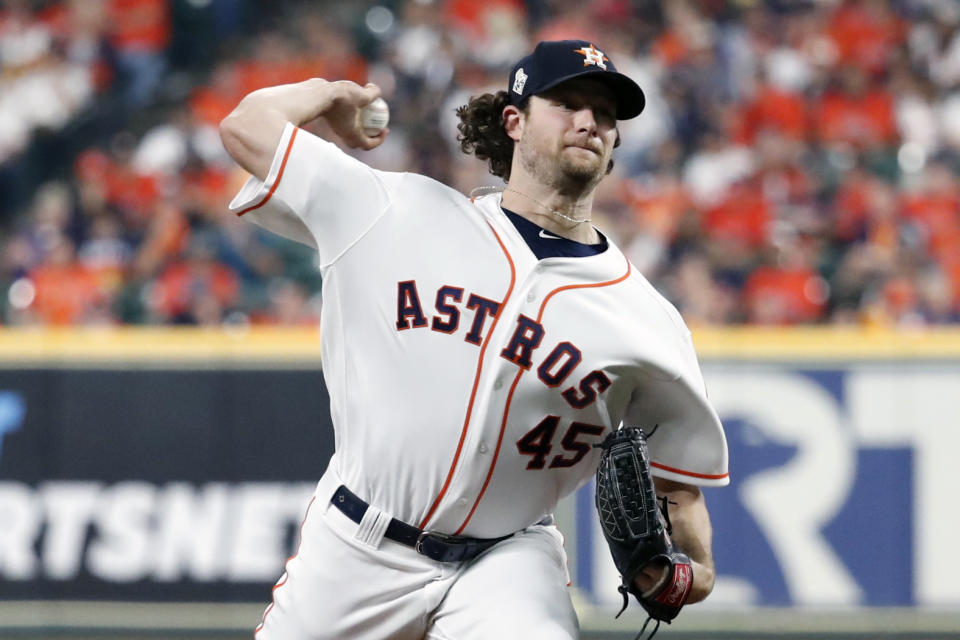Will MLB's record-setting deals trickle down to baseball's middle class?
SAN DIEGO — The best free agent goes to the New York Yankees for the most money and that seems about right. Not everything has to be so complicated.
Gluttony is not without its risks, but, then, over about 30 hours the game seemed to grow this much healthier and the Yankees felt like the Yankees again, which are not unrelated.
Gerrit Cole agreed to become a Yankee for $324 million over nine years, a day after Stephen Strasburg re-became a Washington National for $245 million over seven years, and that this is a second-week-of-December thing and not a February thing is a pleasant reversal of an unsettling trend.
The agent Scott Boras, who represents Cole and Strasburg and is popularly cited as a factor in the stagnancy of last winter and the one before, is instead leading the charge for paper championships. Along with the Cincinnati Reds’ signing of second baseman Mike Moustakas (four years, $64 million), and with still Anthony Rendon, Hyun-Jin Ryu, Nick Castellanos and Dallas Keuchel on deck, Boras already has done $633 million worth of business since Dec. 5, and in the coming weeks could blow past $1 billion in contracts for a single offseason.
You could argue the game seeks competitive footing in an era that has seen to-the-studs rebuilds and luxury-tax avoidance across the league, leading to some uncomfortable conversations between commissioner Rob Manfred and union chief Tony Clark. Massive financial commitments made by the Yankees and Nationals (and the Philadelphia Phillies, who are $118 million into Zack Wheeler) — traditional “haves” in the baseball stratosphere” — will not distract those conversations for long.

A rigorous December, however, if nothing else, soothes the economic and competitive souls at least temporarily. Sure, Cole got his $324 million, but Howie Kendrick also got his $6.25 million and Kyle Gibson his $28 million and Drew Pomeranz his $34 million and Travis d’Arnaud his $16 million. A few agents have muttered that someone somewhere must have given the signal for owners to spend again, or maybe those same owners are beginning to see that a perpetual five-year plan can start to grate on their customers. Or, perhaps, former customers. Now, plenty of discord opportunity remains — what’s so hard about shoveling hundreds of millions of dollars toward the best players? — as a good portion of a squeezed-out middle class remains, and that’s the area that often reflects the relative wellness of baseball’s economy. It doesn’t seem a Bryce Harper or a Manny Machado will drift into spring training again, but a Keuchel or a Craig Kimbrel might still find themselves jobless in June. As important, who gets the jobs that for generations belonged to hearty, baseball-scarred veterans who expect more for their services than minimum wage and a big-league experience?
Meantime, Manfred reiterated Wednesday that postseason attendance, mostly brief, by the Oakland A’s, Minnesota Twins and Tampa Bay Rays would suggest a reasonable amount of parity, and that the system as it stands has actually been pretty good for the game. The union has other ideas, of course.
“I’ve said this, the markets are going to be up and down, but that’s what happens in markets,” Manfred said. “It depends on what players are out there, what financial constraints clubs are under in a particular season. But, over time, it’s important to drop back and remember, we have the freest free agency in professional sports. No rights of first refusal. No salary cap. No franchise tags. None of that. And it has produced the largest amount of guaranteed dollars for players in any professional sport. I know that, you know, if you look back at the [past winter], the activity was later in the market, but you know you go back to Harper, Trout, Machado, Arenado, and then the activity we’ve had already this year, and it’s a really robust market.”
Which is all fine, the hard dollars and cents of it all.
Leave a place for the sentimentality, too. For, 11 years ago the Yankees made a 17-year-old right-hander out of Orange Lutheran High School their first pick in the draft, that being Gerrit Cole. He went to UCLA instead. They’d tried to trade for him two years ago, and lost him to the Houston Astros. That sort of diligence stays with a guy. Not as much as $324 million, but still.
And, then, around the same time the Yankees were first hounding Cole, a college junior named Stephen Strasburg was scheduled to pitch a game at an Urban Youth Academy in Compton. The Nationals had the first overall pick in 2009 and were considering the right-hander from San Diego State. They’d, of course, send scouts. And in the first row of the tiny grandstand area in a far corner of the campus of Compton City College, the two people sitting in the first row were Ted and Annette Lerner. They owned the Nationals. They’d come to see that right-hander.
See, it’s not so complicated. At the end of the day, it’ll cost you a lot of money and a little bit of heart.
More from Yahoo Sports:

 Yahoo Sports
Yahoo Sports 
